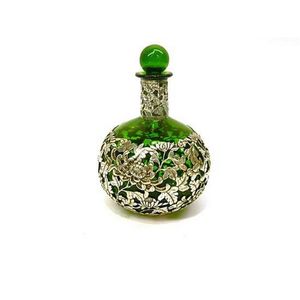Gilded Satsuma Vase with Japanese Landscape
You must be a subscriber, and be logged in to view price and dealer details.
Subscribe Now to view actual auction price for this item
When you subscribe, you have the option of setting the currency in which to display prices to $Au, $US, $NZ or Stg.
- Earthenware - A basic ceramic material that is fired at a low temperature. Earthenware is the basis of almost all ancient, medieval, Middle Eastern and European painted ceramics. After firing, the colour is the colour of the clay when it is dug from the ground: buff, brown and red. It is not waterproof until glazed. Creamware is a type of earthenware covered with a transparent lead glaze. Majolica, faience and delft are also earthenware covered in an opaque white tin glaze.
- Gilding - Gilding is a method of ornamentation whereby a thin sheet of gold metal is applied to items made of wood, leather, ceramics, glass and silver for decorative purposes.
For furniture including mirrors, the sheet of gold is usually applied over a coating of gesso. Gesso is a mixture of plaster of Paris and gypsum mixed with water and then applied to the carved wooden frames of mirrors and picture frames as a base for applying the gold leaf. After numerous coats of gesso have been applied, allowed to dry and then sanded a coat of "bole", a usually red coloured mixture of clay and glue is brushed on and allowed to dry, after which the gold leaf is applied. Over time parts of the gilding will rub off so the base colour can be seen. In water gilding, this was generally a blue colour, while in oil gilding, the under layer was often yellow. In Victorian times, gilders frequently used red as a pigment beneath the gold leaf.
Metal was often gilded by a process known as fire gilding. Gold mixed with mercury was applied and heated, causing the mercury to evaporate, the long-term effect of which was to kill or disable the craftsman or woman from mercury poisoning. The pursuit of beauty has claimed many victims, not the least of which were the artists who made those pieces so highly sought after today.
This item has been included into following indexes:
- Japanese ceramics, item types - other 2,591
-
Satsuma (Japan), item type
- other items 2,099
- vases 1,419
Visually similar items

A Chinese silver & green glass perfume bottle, the pierced relief silver decorations of chrysanthemums covering the side & neck with a green glass stopper, silver marked WH90 (Wah Hing). Height .14 cm

A Grainger's Worcester reticulated vase, circa 1910 with pierced spiralled decoration to the globular body, the elongated knopped neck and scalloped lip similarly decorated, printed factory marks and painted numbers 22 cm high

A Pilkington Royal Lancastrian bird decorated lustre vase, circa 1920, by Richard Joyce, impressed Royal Lancastrian, England, 2107, and monogrammed R. J, 17 cm high

A Chinese famille rose porcelain double gourd wall vase, decorated with panels of landscapes on scrolling flower background. Red Qianlong four character mark on base. Height 20 cm
